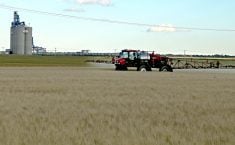SASKATOON — A prolonged hot and dry spell has withered notions of a Prairie-wide bumper crop.
Brian Allison, who runs a mixed farming operation near Red Deer, Alta., said the growing season started out full of promise.
His farm received more than 89 millimetres of rain in May.
Read Also

House ag committee to undertake several studies
The House of Commons standing agriculture committee has set its agenda for the coming months. Members began the fall sitting with a two-hour update on international trade
“We had really good moisture for germination,” said Allison. “We were fairly optimistic.”
However, the rain has since dried up. He received 32 mm June 27 and another 25 mm on half of his 2,000 acres of cropland toward the end of July.
In total, he estimates his farm received 133 to 165 mm of rain between May 1 and July 31, which is about half of what he would get in a decent year.
“Pastures are basically drying up. I had to spray grasshoppers on two of my three pastures here three days ago,” said Allison.
Everybody’s wheat in the surrounding area turned during the past week.
“It’s prematurely ripening. The top third of the heads in a lot of the crops aren’t filling,” he said.
Allison’s canola was not in bloom very long this year. He thinks the yield will be disappointing after showing much promise earlier in the growing season.
“The way it was originally coming up, we would have had a chance at 55 or 60 bushels,” he said.
“I think we’ll be lucky to get 35 now.”
The wheat will probably yield 50 to 55 bu. compared to 85 last year.
Allison just cut a field of silage that produced five tonnes per acre. That same field delivered double that volume last year.
Crops between Stettler and Red Deer are all going backward.
“This is a big central Alberta issue for sure. It’s not just me,” said Allison.
In fact, his son just returned from a trip that took him 1.5 hours north of Edmonton and he only saw one canola crop better than theirs.
“There’s no bumper crop in Alberta,” said Allison.
That dire assessment is corroborated in the July 23 provincial crop report.
“The recent heat was prolonged enough that major crop conditions significantly declined from 73 per cent good to excellent last week to 55 per cent good to excellent,” stated the report.
Conditions are now rated below the five- and 10-year averages of 57 and 62 per cent good to excellent.
Saskatchewan’s crop report contained more bad news.
“Another hot, dry week has many producers worried about their crops, especially in southern and western portions of the province,” stated the report dated July 25.
“Multiple extremely hot days during the critical flowering stage of many crops has likely lowered yield potential in some areas.”
Allison said if rain comes in early August, his canola could gain another 10 bu. per acre, and some of his later-seeded wheat and barley would benefit as well.
“But I don’t see anything in the forecast,” he said.
He is thankful for what he has in the fields, but the yields will likely end up 30 to 40 per cent lower than last year, while grain prices are down 25 to 30 per cent.
“We’re definitely not going to have the same cash flow we had last year,” said Allison.
Fortunately, his fertilizer bill was 30 to 40 per cent lower than last year, and his glyphosate costs came down a lot as well.


















